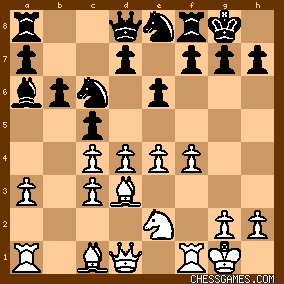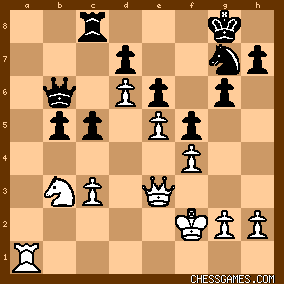| DrGridlock: Really cool game - which deserves some analytic comments. Game appears with comments in both Victor Moskalenko's "Revolutionize Your Chess" and in John Watson's "Mastering the Chess Openings: Volume 2." Moskalenko presents the game as part of a section on the Nimzo-Indian Samisch Variation, and in particular in a discourse on "A Pawn Sacrifice and a Captive Knight." Moskelenko writes, "Here is one of my discoveries that may still (in 2009) be of theoretical and practical interest. After 11 f4 
click for larger viewWe are in one of the key positions of the Samisch Variation ... Normally, Black's strategy is to block the central white pawns, whereas White tries to attack at all costs, smashing through everything that gets in his way. Then I found a different concept that is based on a strategic trick: after the best blocking move 11 ... f5 I tried 12 d5 !? ... If Black accepts the pawn sacrifice with 13 ... Bxc4, this allows White to imprison Black's knight: 14 Bxc4 Nxc4 15 d6! ... Here is my main idea. Now the king's knight is locked into a prison and it has only three available squares: e8, g7 and h5." Milov adopts this line in his game against Polgar. Milov writes, "This was the idea behind White's 12'th move. If now Black accepts the pawn sacrifice, then after d5-d6 White locks in the e8 knight." The positional value of White's game after the pawn sacrifice might be over-rated. Moskolenko wrote after White's move 21 Nc1, "After trading off all the pieces except the knight on e8, Black will have a hard time to defend his queenside weaknesses." Watson might have been closer to an accurate assessment when he wrote, "The game continued and White recovered his pawn with a superior position. Some wild tactics ensued but eventually he won." Credit the "wild tactics" more than the "superior position" for White's win. Computer analysis reveals that after as an alternative at move 22, black can play: 22 ... Nxe3
23 Qxe3 Rc8
24 Kf2
reaching this position:

click for larger viewWhile Moskelenko wrote about "queenside weaknesses" there really are none for Black in this line. The c3 pawn prevents white from ever attacking black's c-pawn with White's rook. Black can always defend the c-pawn with her queen and rook while White can never bring more than his queen and knight in attack. Meanwhile, the rest of the position is virtually closed. Computer moves in this position merely "dither" moving rooks, kings and knights back and forht, with no possibility of a break-through on either side for black or for white. In a nutshell, this position is dead drawn! Except the tactics behind the scenes are, as Watson notes, quite hair-raising. It says something that in pure tactics, Milov out-calculates Polger and wins the game. Black's moves 28, 29 and 30 dig Polger into a hole from a drawn position. | 




